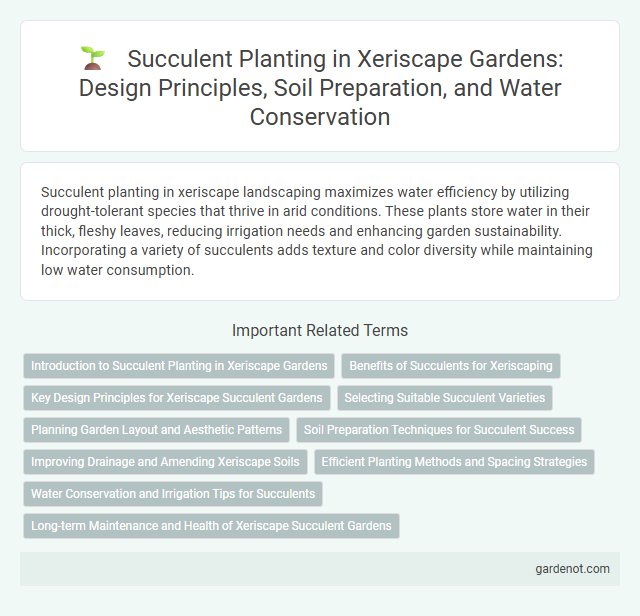Succulent planting in xeriscape landscaping maximizes water efficiency by utilizing drought-tolerant species that thrive in arid conditions. These plants store water in their thick, fleshy leaves, reducing irrigation needs and enhancing garden sustainability. Incorporating a variety of succulents adds texture and color diversity while maintaining low water consumption.
Introduction to Succulent Planting in Xeriscape Gardens
Succulent planting in xeriscape gardens emphasizes using drought-tolerant species like Agave, Aloe, and Echeveria to conserve water while enhancing landscape aesthetics. These plants have thick, fleshy leaves that store moisture, making them ideal for arid climates and reducing irrigation needs by up to 50%. Incorporating succulents supports sustainable gardening practices by minimizing water usage and maintenance in xeriscaping designs.
Benefits of Succulents for Xeriscaping
Succulents significantly enhance xeriscaping by requiring minimal water, making them ideal for drought-prone areas and water conservation efforts. Their ability to store water in thick, fleshy leaves reduces irrigation needs while maintaining vibrant, low-maintenance landscaping. Succulents also improve soil retention and prevent erosion, contributing to sustainable and resilient garden ecosystems.
Key Design Principles for Xeriscape Succulent Gardens
Succulent planting in xeriscape gardens emphasizes water-efficient design principles such as grouping plants by water needs, selecting drought-tolerant species, and using well-draining soil to prevent root rot. Strategic placement maximizes sun exposure while minimizing evaporation, incorporating mulch and rocks to retain moisture and reduce weed growth. These key design principles ensure sustainable, low-maintenance succulent gardens that thrive in arid climates.
Selecting Suitable Succulent Varieties
Choosing suitable succulent varieties for xeriscape gardens involves prioritizing drought-tolerant species such as Echeveria, Sedum, and Agave. These succulents thrive in low-water conditions, providing vibrant foliage while minimizing irrigation needs. Selecting native or regionally adapted succulents enhances resilience and supports sustainable water conservation efforts.
Planning Garden Layout and Aesthetic Patterns
Succulent planting in xeriscape garden layout requires strategic spacing to accommodate growth and ensure proper drainage, promoting plant health and longevity. Arranging succulents in repetitive geometric patterns enhances visual appeal while conserving water through grouped irrigation zones tailored to drought-tolerant species. Incorporating varied textures and colors, such as rosette echeverias and trailing sedums, creates dynamic aesthetic patterns that thrive in low-water environments.
Soil Preparation Techniques for Succulent Success
Succulent planting thrives with well-draining soil, emphasizing the importance of soil preparation techniques such as mixing coarse sand, perlite, or pumice to enhance drainage and prevent root rot. Amending garden soil with organic matter like compost fosters nutrient availability while maintaining minimal moisture retention for succulent health. Proper soil aeration and pH balance around 6.0 to 7.0 optimize root development, supporting robust succulent growth in xeriscape landscapes.
Improving Drainage and Amending Xeriscape Soils
Succulent planting thrives in well-drained soils that prevent water retention and root rot, making soil amendment essential in xeriscape landscapes. Incorporating coarse sand, perlite, or pumice improves drainage and aeration, while organic matter like compost enhances nutrient content without compromising soil structure. Proper soil preparation ensures succulents establish strong root systems, promoting drought resilience and minimizing irrigation needs.
Efficient Planting Methods and Spacing Strategies
Succulent planting in xeriscape gardens requires efficient methods such as grouping plants by water needs and using raised beds or rock mulch to improve drainage and reduce water use. Proper spacing strategies involve placing succulents at least 6 to 12 inches apart, depending on the species, to allow airflow and prevent root rot while accommodating growth patterns. These techniques enhance water conservation, promote healthy plant development, and minimize maintenance in drought-tolerant landscapes.
Water Conservation and Irrigation Tips for Succulents
Succulent planting is a key xeriscaping strategy that maximizes water conservation by requiring minimal irrigation due to their drought-resistant nature. To optimize water usage, irrigate succulents deeply but infrequently, allowing the soil to dry out completely between waterings, which prevents root rot and promotes healthy growth. Using well-draining soil and mulch further reduces evaporation, ensuring succulents thrive with efficient water management in arid landscapes.
Long-term Maintenance and Health of Xeriscape Succulent Gardens
Succulent planting in xeriscape gardens requires minimal but consistent long-term maintenance to ensure plant health and water conservation. Regular monitoring for pests and diseases, along with occasional pruning to remove dead leaves, supports succulents' resilience in arid environments. Proper soil drainage and seasonal fertilization promote vigorous growth and sustain the vibrant appearance of xeriscape succulent gardens over time.
Succulent planting Infographic

 gardenot.com
gardenot.com